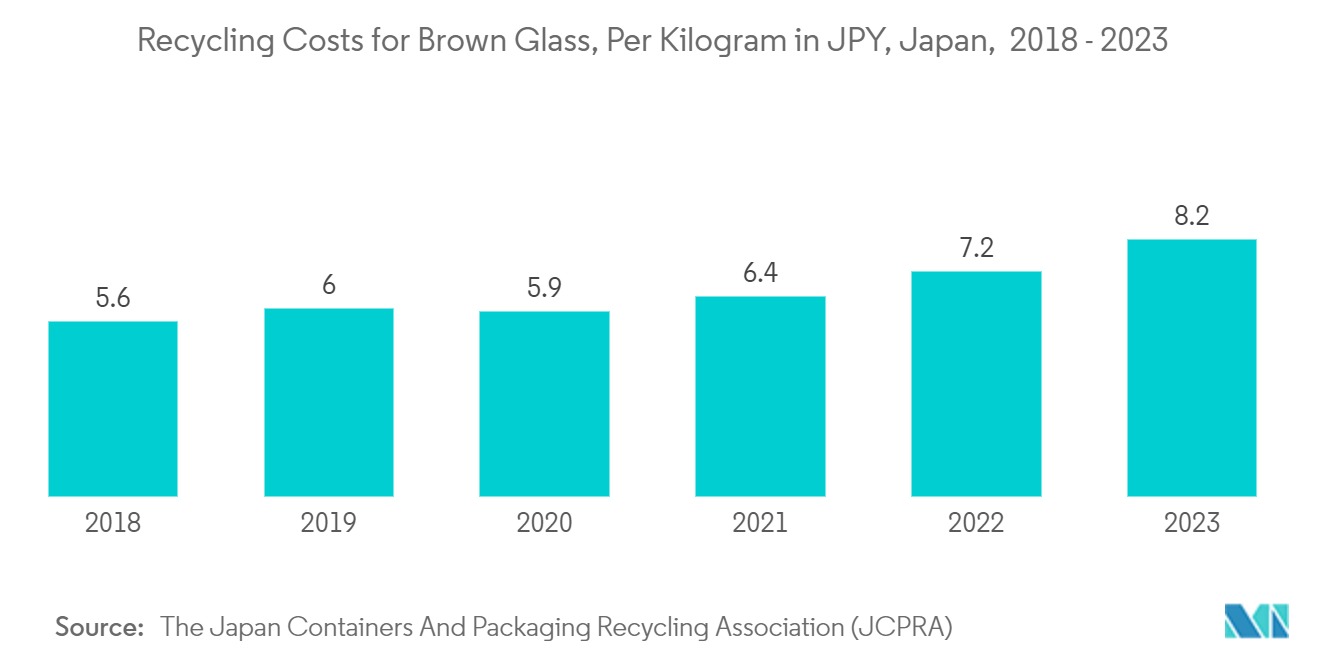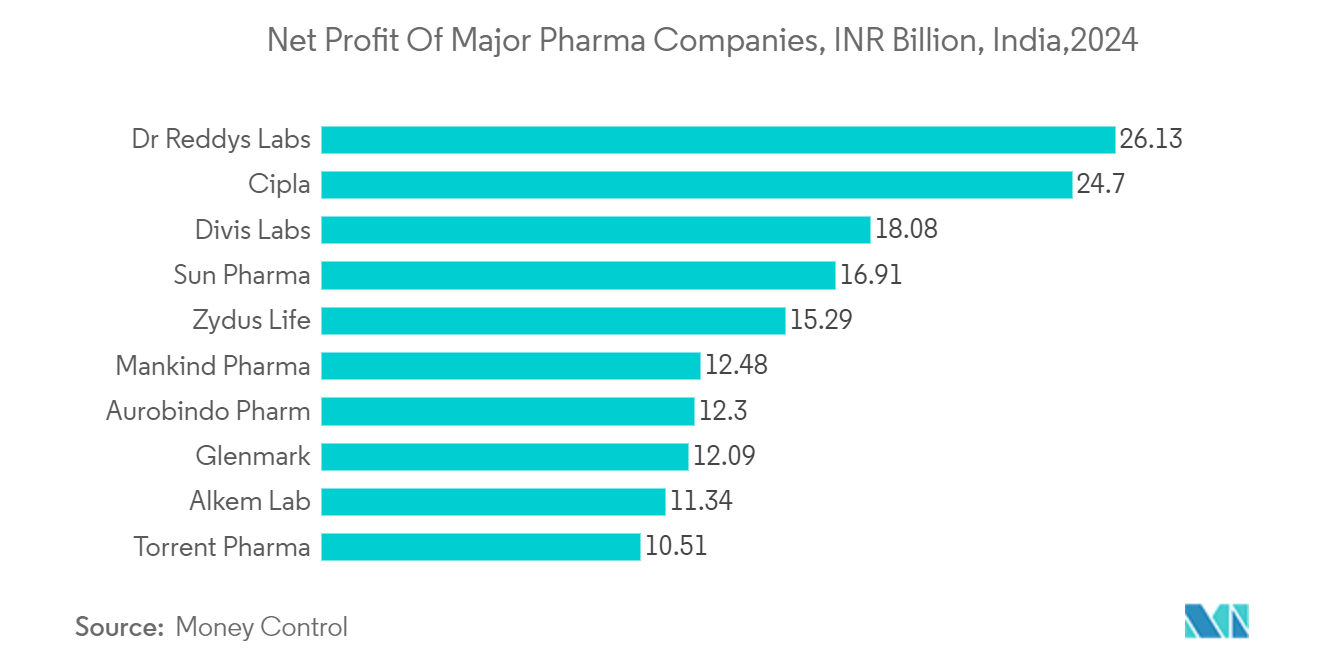Market Trends of Asia Pacific Pharmaceutical Packaging Industry
Glass Packaging is Expected to Witness Significant Growth
- Glass packaging is offered mainly as the primary packaging for pharmaceutical products and is among the leading packaging materials for the pharmaceutical industry. This is primarily due to advantages such as being sustainable, inert, impermeable, recyclable with no loss in quality, and reusable. Glass containers are among the primary packaging materials that have found significant use in the pharmaceutical industries.
- The glass shows great ability in controlling and storing pharmaceuticals. Many pharmaceutical products are packed in glass containers because they can offer safety in a wide variety of environments. Daiichi Glass has developed pharmaceutical bottles such as lightweight vial bottles for injection and lightweight PS bottles for tablets.
- The market growth is supported by the increase in glass container shipments in end-use markets. Glass containers are one of the most preferred materials for packaging liquid-based pharmaceutical products, chemicals, and other perishable/non-perishable products. Moreover, the rising preference for environment-friendly packaging solutions impacts pharmaceutical glass packaging adoption. The APAC Region is witnessing an increased demand for Glass packaging, the most common material used in pharmaceutical packaging, because of its characteristics that allow for easy sanitation and transparency of its substance.
- Moreover, the rapidly increasing demand for injectable pharmaceuticals is also significantly driving the growth of glass-based products in the pharmaceutical sector. The market for oncology and other high-potency drugs such as steroids, antibody conjugates, and IV fluids that require quick onset of action is also expected to be a key growth driver.
- The introduction of stringent laws to enhance the quality and integrity of domestically manufactured drugs has led to an increase in the usage of glass for pharmaceutical packaging solutions. Also, the rising demand for sterile medical packaging products from the industry would further drive the market's growth over the forecast period. Additionally, the market has an increasing recycling glass cost, and many companies have expanded their production capacities and manufacturing capabilities due to the COVID-19 pandemic.
- According to a report from the Japanese Containers and Packaging Recycling Association, the cost of recycling brown glass in Japan reached JPY 8.2 thousand (USD 0.0567 thousand) per ton by 2023. In the past year, figures have been increasing on a steady basis and reaching their peak. Companies may be encouraged to invest in research and development for new packaging technologies due to the increased recycling costs associated with Brown Glass. Creating new materials and packaging designs that are more environmentally friendly and cost-effective can also be part of this. This innovation can make it possible for the pharmaceutical glass market in the Asia-Pacific to grow by providing better packaging solutions.

India is Expected to Witness Significant Growth
- The pharmaceutical packaging industry has been experiencing substantial growth for several years. Due to innovations and emerging treatments, there is room for further growth in this section of the pharma industry. The COVID-19 pandemic brought a new awareness of the need to package and distribute products efficiently. There will likely be expectations to manufacture and distribute products quicker, right down to the packaging. Packaging companies are expected to face new pressures to develop solutions to get things moving faster and increase demand.
- The investment of the packaging vendors is growing rapidly, contributing to the market's growth. For example, in February 2023, Telangana Government announced an INR 500 crore (USD 61 million) investment in the pharma industry. A collaboration between Corning Incorporated and SGD Pharma, a pharmaceutical primary packaging company. The collaboration facility for pharmaceutical packaging and glass production will be established in Telangana.
- Furthermore, in May 2022, Gerresheimer ramped up pharma packaging capacity in India. The company has significantly ramped up its glass and plastic production capacities in India with new facilities and capabilities. By adding capacities in India, Gerresheimer executes its growth strategy in Emerging Markets, addressing the global megatrend for increasing healthcare access in these markets and the rising demand for vaccination.
- The initiative taken by the Indian government to improve the healthcare sector is also one of the important factors for market growth. The Government of India introduced the Production Linked Incentive (PLI) scheme to encourage domestic manufacturing and achieve an AtmanirbharBharat. The adoption and compliance with regulatory norms in pharmaceutical packaging and standards about packaging recycling have bolstered the growth of the pharmaceutical packaging market in India.
- In June 2022, India had multiple challenges, and providing the best healthcare to a burgeoning population was one of the most critical tasks. Despite improvements in the healthcare sector, chronic diseases are surging rapidly. As per a WHO report, 20% of the country's population suffers from at least one non-communicable disease, and the treatments are estimated to cost India USD 6.2 trillion by 2030. Research and development at pharmaceutical companies have driven the growth of the pharmaceutical packaging market in India.
- According to Moneycontrol, as of July 2022, Cipla was the leading pharmaceutical business in India, with a net profit of approximately INR 30 billion (USD 0.36 billion). Divis Labs and Glenmark came in second and third, with net profits of around INR 29 billion (USD 0.35 billion) and INR 20 billion (USD 0.24 billion) during the specified time frame, respectively. Increasing a pharmaceutical company's net profit can contribute to increased demand for pharmaceutical products, investment in R&D, advanced packaging technologies, and increased outsourcing, all of which can help the pharmaceutical packaging market grow.

